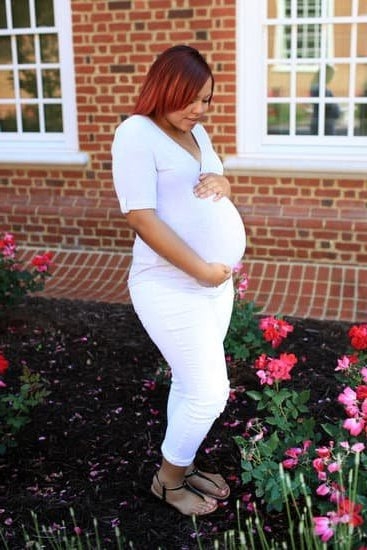Introduction
Pregnancy is a time of great physical, emotional, and spiritual changes for any woman. The process of pregnancy begins when an egg released from a woman’s ovaries meets with sperm provided by a male partner, during sexual intercourse.
This is when conception can take place. Through different stages of early development, the fertilized egg becomes an embryo, which then transforms itself into a fetus after the first six weeks. This timeframe marks the beginning of pregnancy, and it is considered full-term at 40 weeks.
Once the egg has been successfully fertilized and implanted in the uterus wall, a breakthrough occurs in which hormones are secreted to begin increasing blood flow to the uterus, thickening its walls for better support of a developing baby.
The hormonal levels also trigger signs that indicate a successful pregnancy – elevated basal body temperature (BBT), increased fatigue due to increased progesterone levels in the body, and having missed periods or delayed menstruation cycles due to human chorionic gonadotropin (hCG) present in pregnant women’s bodies. Over these nine months of gestation period, an expecting mother undergoes several changes such as her body weight gaining 30-35 pounds beyond her pre-pregnancy weight.
Aside from physical developement which includes an enlargened uterus and breasts towards producing more milk for breastfeeding; she will start feeling motion and fetal movement taking place inside her womb when fet presses against her abdominal wall.
At this point, monthly prenatal checkups are recommended to ensure all aspects of development healthily progresses until childbirth where labor contractions begin leading into delivery depending on various birth plans chosen by mothers prior to their childbirth events preparing them for their big day!
Sperm and the Egg
Pregnancy begins with an actual process called fertilization where one sperm from a male, meets and penetrates the egg from a female. This forms a single cell which will eventually divide and grow into a fetus over the course of nine months. In order for fertilization to occur, a sperm must successfully make its way through the outer layers of the egg (also called ovum) wall. For this to happen, there must be enough sperm present in close proximity to the egg so that one can penetrate its outer shell; around 200-400 million may be required in some cases. Once inside, chemical reactions between components on the surface of each cell allow further entrance of the sperm into the ovum. As soon as the two cells fully fuse together, their genetic material combines and forms something unique; zygote — a total form of genetic combination that will determine an individual’s features and ethnic origin! The zygote then produces hormones that signal to the endometrium of uterus that it is ready to receive it and implantation takes place. At this stage, pregnancy has officially begun!
Sperm vs. Egg—Exploring the Differences
Pregnancy begins when a sperm meets an egg and successfully fertilizes it. In order to understand fertility and pregnancy, first we must examine the differences between sperm and eggs. Sperm cells are the male reproductive cells, and they are produced in the testes of males. Sperm is tiny compared to the egg and can only swim short distances before they die. Sperm contain 23 chromosomes that hold information about gender, as well as other physical characteristics.
In contrast, an egg is usually much larger than a single sperm cell; it also carries fewer chromosomes—just one set of 23 with no information about gender or other physical traits. A woman normally releases one mature egg at ovulation into her fallopian tube, where it sits for 24-48 hours waiting for fertilization from a sperm before it continues its journey toward the uterus. The egg has to be alive and healthy in order to be fertilized by a successful spermcell; therefore an important factor in Pregnancy is having healthy eggs on hand at ovulation time that can be successfully fertilized by a viable sperm cell.
Understanding Fertilization
The onset of pregnancy begins with fertilization, the moment when a sperm meets an egg and they join together to form a single cell. This single cell has the genetic material of both the mother and father combined, forming a unique embryo. When the sperm penetrates the egg’s outer membrane, it triggers a series of changes within the egg that prevent other sperm from entering. The sperm’s nucleus also fuses with that of the egg to form one nucleus containing genetic information for this new individual. Once this fusion occurs, the newly formed embryo undergoes a process known as cleavage, in which it divides and forms two cells. These two cells will then divide again, forming four cells, then eight cells, and so on until an early stage baby is formed.
Ovulation and How It Triggers Pregnancy
Pregnancy begins with ovulation, a natural process in which an egg is released from one of the woman’s two ovaries into the uterus. In order for the egg to be fertilized and eventually create a pregnancy, it must be released at approximately the right time throughout a woman’s cycle, so that it may come into contact with sperm that has been ejaculated into the female reproductive tract by her partner. The release of the egg is caused by changes in the hormones produced and secreted by the pituitary gland. These hormones stimulate the growth of follicles within each ovary and cause eggs to develop and mature. At around day 14, one of these eggs will be released through an opening in each ovary known as a ‘follicular rupture’. Following this event, during days 15-19 (depending on individual variability), if sperm cells are present in or near the reproductive tract then there is potential for an egg to be fertilized before travelling down through fallopian tubes. Once an egg becomes fertilized by sperm it can implant itself into thickened lining of uterus typically 6-10 days following ovulation where it will begin its development inside the womb leading to a successful pregnancy.
Body Changes That Occur During Pregnancy
Pregnancy is an exciting and important time in a woman’s life, and it begins with conception. Conception occurs when the male sperm penetrates the female egg, enabling the development of a unique individual. After conception, there are many body changes that occur during pregnancy to support the growing fetus inside of the mother.
First and foremost, within days of conception, levels of hormones in a woman’s body increases dramatically – which can cause fatigue, nausea, or tender breasts. As early as 6 weeks into pregnancy, noticeable enlargement of the uterus will occur as well as the increase of blood flow to the pelvic area causing natural discomfort known as round ligament pain.
As months pass on in a pregnancy journey (approximately 6-8 months), women may note an increased appetite due to their bodies working harder than usual to support a baby’s growth – so nourishment is necessary for them both. Physically speaking, skin appears sensitive and some pregnant women tend to experience acne breakouts or even patches of darker skin pigmentations throughout their face from hormonal changes. A baby bump will become visible soon enough due to enlargement of uterus stretching around belly area while weight gain is also common throughout this period. Other physical changes include insensible nosebleeds caused by higher levels of estrogen in women’s body or spider veins that may appear out of nowhere during late trimesters due to increased pressure on veins.
Though physical changes are usually at the utmost priority for expecting mothers regardless these bodily shifts may be uncomfortable at times but all these undergoings signify progression for a successful transition into delivery day!
Risks and Symptoms of Pregnancy
Pregnancy begins when an egg and sperm meet, for most people through sexual intercourse. The egg is then fertilized by the sperm and implants itself in the uterine lining. If a woman becomes pregnant, her body will start to produce hormones, such as progesterone and hCG that help to prepare the body for pregnancy.
Risks of pregnancy include gestational diabetes, high blood pressure, preterm labor, miscarriages and more. Some of the common symptoms of pregnancy are nausea, fatigue, tender breasts, backaches , mood swings and cravings for certain foods. Other signs can include missed periods or spotting and changes in skin color or texture due to increased levels of estrogen in your system.
Steps to Improve Fertility
Pregnancy begins when a sperm fertilizes an egg. For pregnancy to occur, the couple must be aware of their respective fertility windows, or those days in each menstrual cycle where conception is more likely to occur. To improve fertility and increase the likelihood of becoming pregnant, both partners should focus on making healthy lifestyle choices like eating a balanced diet, exercising regularly and avoiding smoking. Additionally, couples should also discuss any preconception supplements they should take to ensure optimal reproductive health as well as scheduling any necessary medical tests that may help identify any potential fertility issues. Once a woman begins trying to conceive it’s important for her to track her cycles by charting her temperatures and monitoring changes in cervical mucus so she can determine when she is ovulating. If necessary, couples can also visit their doctor or use over the counter ovulation prediction kits which helps alert them to their fertile period. Understanding one’s current level of fertility and knowing how to improve your chances of getting pregnant is key for successful conception.
Conclusion
Once the basic understanding of how pregnancy begins is understood, there are a few important things to consider when preparing for pregnancy. One key point to remember is that it can take up to six months to conceive. Therefore, it’s essential that couples plan ahead and start making lifestyle changes well in advance of trying for a baby. This can include quitting smoking, reducing or limiting alcohol consumption and making any necessary dietary changes. Furthermore, couples should get regular check-ups before pregnancy to ensure they are both physically healthy and fit enough for conception. In addition the couple should discuss any mental health issues or family medical conditions that could impact their fertility journey. Finally, partners should also explore contraception options early on so they can begin using them as soon as possible if desired. All these preparations will help improve the chances of getting pregnant and having a healthy birth outcome for mama and baby alike

Welcome to my fertility blog. This is a space where I will be sharing my experiences as I navigate through the world of fertility treatments, as well as provide information and resources about fertility and pregnancy.




